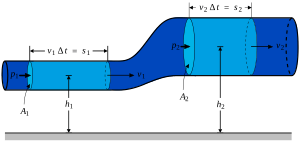Navier–Stokes equations facts for kids

| Mechanics | ||||||||||

|
||||||||||
The Navier–Stokes equations are special math rules that help us understand how fluids move. Fluids are things like water or air. These equations are named after two smart people: Claude-Louis Navier and George Gabriel Stokes.
These equations come from applying Newton's second law (which talks about how forces make things move) to fluids. They also consider that a fluid has internal forces, like pressure and viscosity. Viscosity is like how "thick" a fluid is, for example, honey is more viscous than water.
Contents
Why Are These Equations Important?
Many important things around us involve fluids moving. Scientists and engineers use these equations a lot. They help them create mathematical models for many real-world situations.
For example, they are used to study:
- How weather patterns form.
- How ocean currents flow.
- How water moves through pipes.
- How air flows around an airplane wing.
- How stars move inside a galaxy.
The Navier–Stokes equations, in their full or simpler forms, are super helpful. They assist in designing aircraft and cars. They also help study how blood flows in our bodies. Engineers use them to design power stations. They even help analyze pollution in the air or water.
These equations can also be combined with Maxwell's equations (which describe electricity and magnetism). This helps scientists understand how fluids that can conduct electricity react to magnetic fields.
A Big Math Challenge
The Navier–Stokes equations are also very interesting to mathematicians. Even though they are so useful, mathematicians haven't yet proven some big things about them.
For example, they haven't proven that solutions (answers) to these equations always exist in three dimensions. They also haven't proven that if solutions do exist, they won't have any "bad points" where they become infinite (endless).
This is such a big challenge that the Clay Mathematics Institute has called it one of the seven most important unsolved problems in mathematics. They even offered a US$1,000,000 prize to anyone who can solve it!
Understanding Fluid Movement
The Navier–Stokes equations don't tell us where a fluid particle is. Instead, they tell us its velocity. Velocity means how fast the fluid is moving and in what direction.
When you solve these equations, you get something called a "velocity field" or "flow field." This is like a map that shows the speed and direction of the fluid at every point in space and time. Once you know the velocity field, you can figure out other things. For example, you can find out how much fluid is flowing or how much drag force an object experiences.
This is different from what you usually see in classical mechanics. In classical mechanics, you often track the exact path of a single particle over time. For fluids, it makes more sense to look at the velocity of the whole flow. However, for visualizing, you can still imagine paths that individual fluid particles might follow.
Images for kids
See also
 In Spanish: Ecuaciones de Navier-Stokes para niños
In Spanish: Ecuaciones de Navier-Stokes para niños


